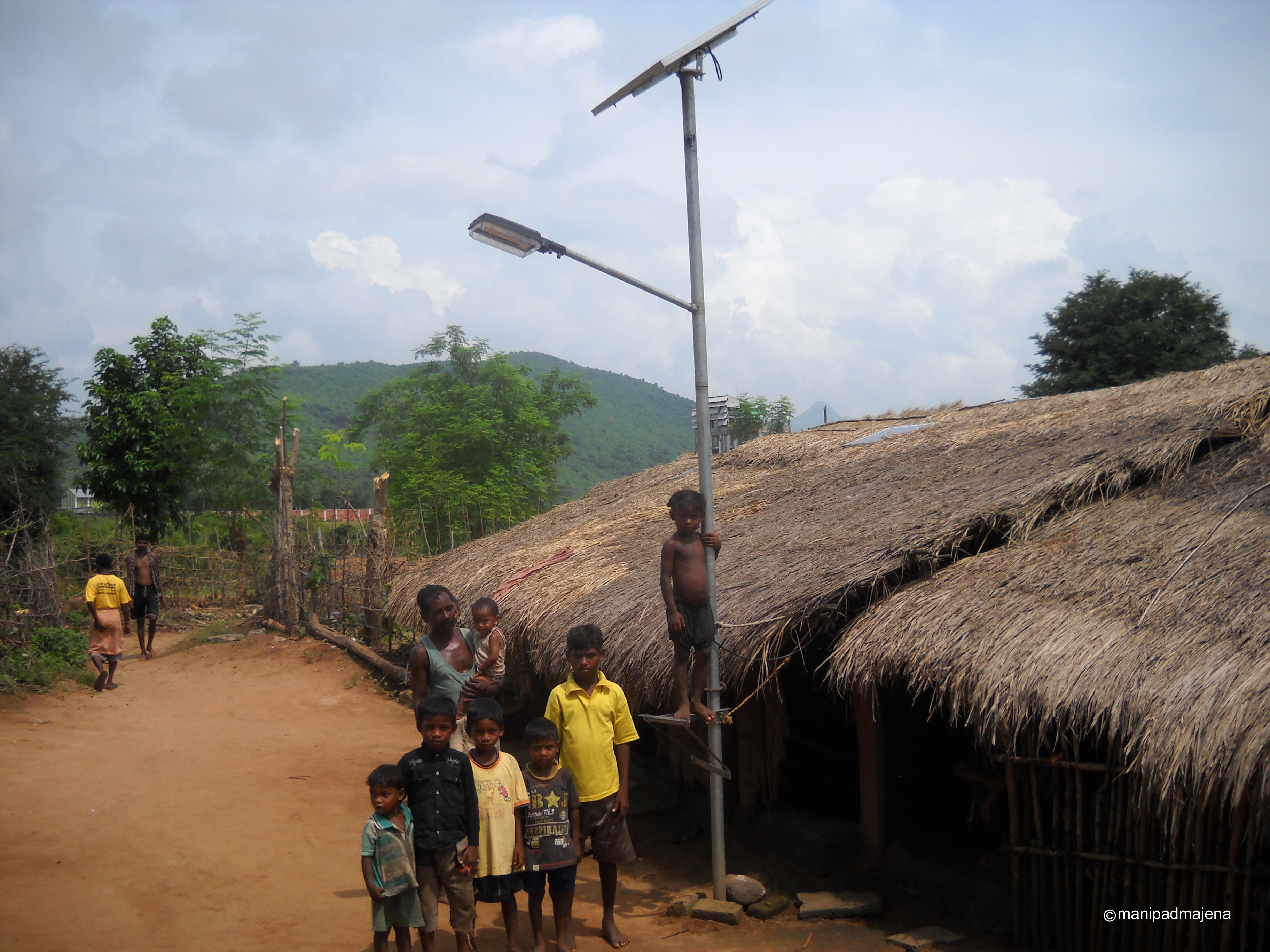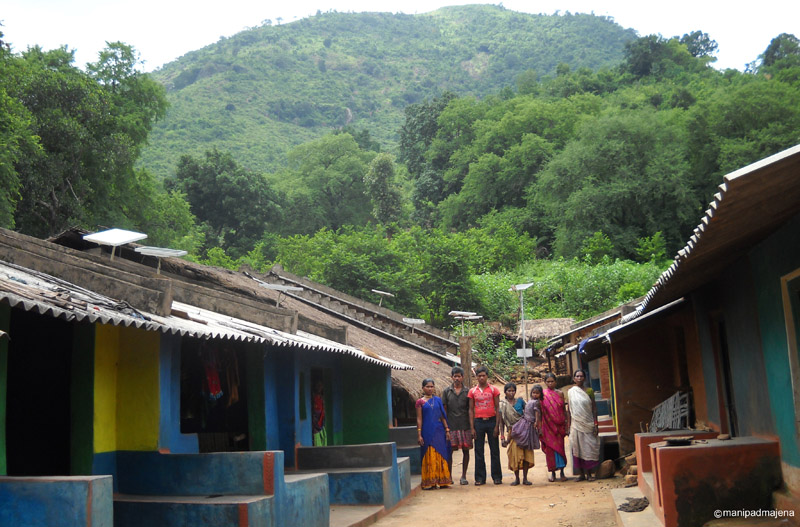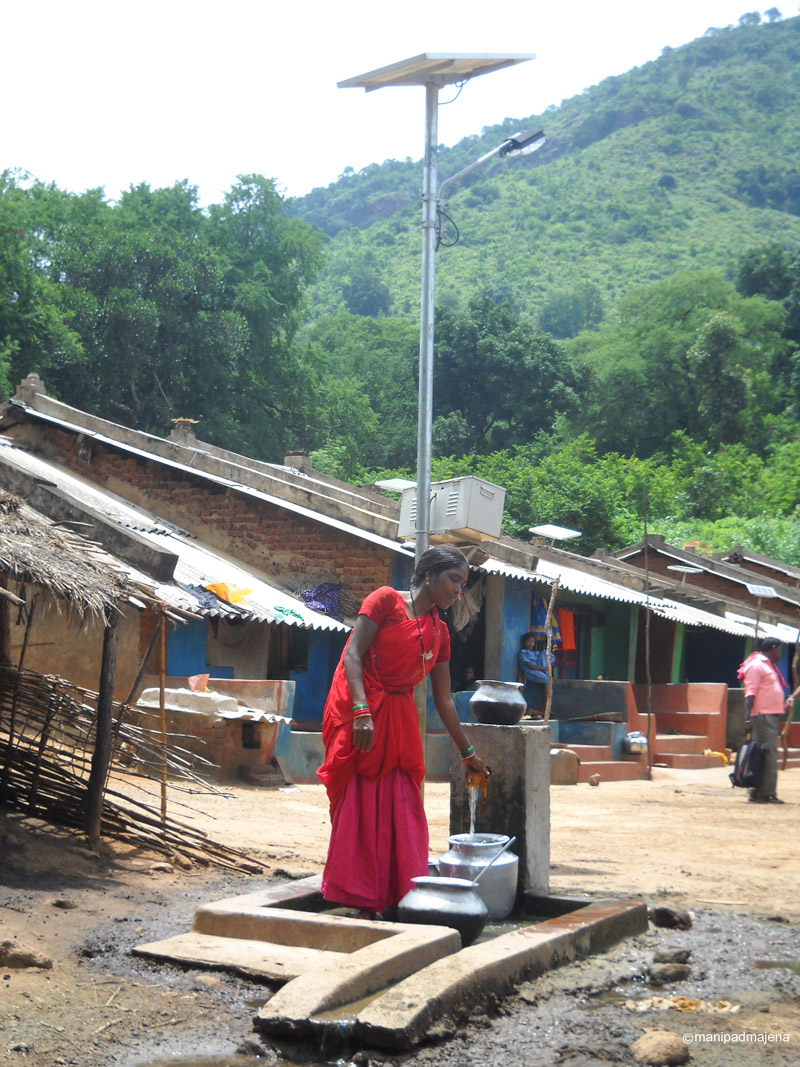
RAYAGADA, India, 15 September 2013- Eight months each of the eleven Kondh tribal households in Balinaikaguda forest village got two 9-watt compact fluorescent lamps (CFLs) and one solar street lamp. After this, all of the nine primary school going children were made to congregate under the street lamp and do their school tasks, watched over by mothers while they cooked by their doorways.
After examination results were announced mid-summer, the school teacher passing by the mothers working in the millet fields, enquired if Khetramani Batraka who all knew had migrated to Chennai city was back, and tutoring the kids. Twenty-six-year-old Batraka after failing his eighth standard examinations had quit school. He was the highest educated person in Balinaikaguda.
Since Batraka had not helped, credit for the children’s improved performance went to the streetlight, by default.
More has changed in 365 villages in Rayagada province in the eastern Indian State of Odisha, after households got two 9-watt compact fluorescent lamps (CFL) powered by a 12-volt solar battery that can provide four to five hours of light and a solar street light for every ten houses under India’s flagship off-grid renewable energy programme – the Remote Village Electrification Programme (RVEP). In remote villages where grid connectivity is either not feasible or not cost effective, 61,000 poorer households in 950 remote rural habitations of Odisha have got this free utility, while work is in progress in 700 more villages. According to National Census 2011 in Odisha only 36.6 percent households were electrified, among the lowest in India.
 In 31-household Erukuti village, annual household incomes reach around 30,000 rupees ($480), comparatively high for the remote area. Nestling in a lush green valley of natural streams that abundantly irrigate paddy and millet fields, the hills range gives seasonal tamarind, turmeric, jackfruit, orange, mango and bananas. When the solar kit- with the two CFL, a 12-volt solar battery and a solar panel was installed, Jagarao Jilakara in his early twenties, raring to enjoy the good life that a cell phone offered a doorway to, went ahead and bought a cell phone for 2000 rupees ($32). Twenty other families in the village did the same to watch movies on their phone’s 3 square centimeters screen. There is no telecommunication network in this remote area.
In 31-household Erukuti village, annual household incomes reach around 30,000 rupees ($480), comparatively high for the remote area. Nestling in a lush green valley of natural streams that abundantly irrigate paddy and millet fields, the hills range gives seasonal tamarind, turmeric, jackfruit, orange, mango and bananas. When the solar kit- with the two CFL, a 12-volt solar battery and a solar panel was installed, Jagarao Jilakara in his early twenties, raring to enjoy the good life that a cell phone offered a doorway to, went ahead and bought a cell phone for 2000 rupees ($32). Twenty other families in the village did the same to watch movies on their phone’s 3 square centimeters screen. There is no telecommunication network in this remote area.
In 45-household Katikona village, higher up on the hill-range, local school teacher Shankar Padaka is happy his students are able to study evenings. Women too, after working in farms and forests in the daytime, can complete household chores like grinding millet for the family meals under the solar lights.
Deeper in the forests, in Chandrapur block of villages, hyena and wild animals ruled the night, compelling people to retire by sundown, fearful of venturing out in the night. The goat and hen however were regularly preyed upon but the solar street lights have frightened the wild animals away and the snakes too, said 57-year old grandmother Salai Batraka.
Most of the inhabitants of the 365 remote villages in Rayagada under the solar electrification programme share Batraka’s sense of over-all well-being.
IMPROVED LIFE-STYLE FRAGILE, NO MAINTENANCE OF SOLAR LIGHTS
The continuity of the betterment that solar lighting has brought to these villages however seems fragile.
“The major concern is that there is not a single service and maintenance centre for the RVEP installed household and street lights in the entire Rayagada district”, said Loknath Patnaik, a technical local field staff of Odisha Renewable Energy Development Agency (OREDA), which implements the RVEP in the state. The RVEP installations in Rayagada have started in 2008.
“Neither are the two persons from each village trained to fix minor repairs of the solar system, which is mandatory,” said Kishore Kumar Panda another local technical staff of OREDA who has been working with renewable in remote area for over 27 years.
In Balinaikaguda village, elders allege that their thumb print however has been taken on documents by maintenance contractors of Bharat Electronics Limited (BEL), saying two people in their village have been trained. BEL is one of the two public-sector enterprise which install and maintain RVEP systems in Odisha.
 “When the solar systems were installed, the beneficiaries were given simple instructions about what the red and green lights on equipments indicate,” offered Chaturbhuja Mallik, by way of explanation when contacted. Mallik is the maintenance contractor for both BEL and Central Electronics Limited (CEL) for the entire RVEP in Rayagada district.
“When the solar systems were installed, the beneficiaries were given simple instructions about what the red and green lights on equipments indicate,” offered Chaturbhuja Mallik, by way of explanation when contacted. Mallik is the maintenance contractor for both BEL and Central Electronics Limited (CEL) for the entire RVEP in Rayagada district.
“Any complaint can be informed to our staff who sit for this purpose at the Public Distribution System (PDS) shop on the 15th of every month. Complaints for repair can also be left at the District Rural Development Agency (DRDA) office,” added Mallik. DRDA oversees district-level implementation of anti-poverty programmes. The PDS is India’s largest food security programme providing subsidized foodgrains to poorer classes.
According to Mallik, there are three service stations in Rayagada where there should be a total of four in the whole of the district However Mallik admitted that spare components of solar kits that should be stocked at these service centres, are not.
All RVEP installation components are meant to be replaced free of cost up to five years from installation date.
“The service stations are virtually non-existent. Except for one, there are no rooms even taken for any other,” clarified YV Raman, the OREDA Rayagada district supervisory official.
RVEP beneficiaries are having to buy CFL bulbs replacements themselves, paying 300 rupees which is equivalent to 3 days labour wages at the local rate. They are entitled to get free replacements of bulbs, whose lifespan is 6 months – for the 5 years period as well.
“People tamper with the equipments to misuse them and if we reprimand them they say – we give vote to the political party and that is why they have rewarded us with lighting; we will do as suits us,” said Mallik.
In towns 6-pin inverters are sold to facilitate multi-misuse of solar batteries.
After each 3-hour movie that villagers view on their cell phones, the phone needs a 12-hour charge, which often depletes the batteries or asks for frequent distilled water top off, which unless provided, kills the battery.
Mallik also admitted that since some of the beneficiary villages are very remote and took three days to reach, much of it by walking, and there was presence of Naxals – far-left radical communists, providing service to those areas was difficult.
Maintenance and continuity of solar lighting to remote villages is a challenge being faced not only in Odisha but in many places countrywide.
Despite electricity access of India’s rural households having improved from 36 percent in 1994 to around 56 percent in 2011, even now around 74 million rural households are without access to electricity. According to the national census 2011, only 36.6 percent of households in Odisha were electrified, one of the lowest in India.
It may seem paradoxical that in India 90 percent of villages are electrified but a village is declared electrified if only 10 percent of households get power connection. Even where household have electricity access, these are plagued by frequent power outages.
Similarly, remote village households may have access to solar lighting but lack of maintenance could drive them back to the dirty-fuel and getting-costlier kerosene lamps. And Asri Hikakka may lose his current interest in studying hard and just drop out of school.
